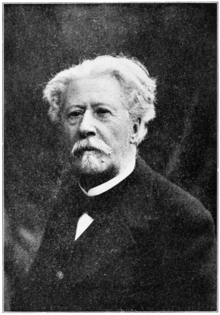Jean Albert Gaudry
| Jean Albert Gaudry | |
|---|---|
 | |
| Born |
September 16, 1827 St Germain-en-Laye |
| Died | November 27, 1908 |
| Nationality | French |
| Occupation |
geologist palaeontologist |
| Awards | Wollaston Medal (1884) |
Jean Albert Gaudry (September 16, 1827 – November 27, 1908), French geologist and palaeontologist,[1] was born at St Germain-en-Laye, and was educated at the Collège Stanislas de Paris.
At the age of twenty-five he made explorations in Cyprus and Greece, residing in the latter country from 1855 to 1860. He then investigated the rich deposit of fossil vertebrata at Pikermi and brought to light a remarkable mammalian fauna, Miocene in age, and intermediate in its forms between European, Asiatic and African types. He also published an account of the geology of the island of Cyprus (Mém. Soc. Géol. de France, 1862).
In 1853, while still in Cyprus, he was appointed assistant to A d'Orbigny, who was the first to hold the chair of palaeontology in the museum of natural history at Paris. In 1872 he succeeded to this important post; in 1882 he was elected member of the French Academy of Sciences. In 1895 he was elected a foreign member of the Royal Society of London.[2] In 1900 he presided over the meetings of the eighth International Congress of Geology then held in Paris. He was elected a member of the Royal Swedish Academy of Sciences in 1900.
He is distinguished for his researches on fossil mammalia, and for the support which his studies have rendered to the theory of evolution. He has also occasionally studied other topics. Among others, he described Early Permian Haptodus baylei, whose affinities he could not determine at the time,[3] but which is now known to be a synapsid closely related to therapsids.[4]
Professor Huxley, comparing our present knowledge of the mammals of the Tertiary era with that of 1859, states that the discoveries of Gaudry, Marsh, and Filhol, are "as if zoologists were to become acquainted with a country hitherto unknown, as rich in novel forms of life as Brazil or South America once were to Europeans."[5]
Publications
.jpg)
- Animaux fossiles et géologie de l'Attique (2 vols., 1862-1867)
- Cours de paléontologie (1873)
- Animaux fossiles du Mont Lebéron (1873)
- Les Enchaînements du monde animal dans les temps géologiques (Mammifères Tertiaires, 1878 ; Fossiles primaires, 1883; Fossiles secondaires, 1890)
- Essai de paléontologie philosophique (1896)
Brief memoir with portrait in Geol. Mag. (1903), p. 49.
Notes
- ↑ Glangeaud, Philippe (1910). Albert Gaudry and the Evolution of the Animal Kingdom, from the Smithsonian Report for 1909, pages 417–429. Washington Government Printing Office.
- ↑ Woodward, Arthur Smith (Dec 10, 1908). "Obit. Albert Gaudry". Nature 79: 163–164. doi:10.1038/079163a0.
- ↑ Albert Gaudry (1886). "Sur un nouveau genre de Reptile trouvé dans le Permien d'Autun". Bulletin de la Société Géologique de France, 3ème série 14: 430–433.
- ↑ Michel Laurin (1993). "Anatomy and relationships of Haptodus garnettensis, a Pennsylvanian synapsid from Kansas". Journal of Vertebrate Paleontology 13 (2): 200–229. doi:10.1080/02724634.1993.10011501.
- ↑ Hutchinson, Henry Neville (1893). Extinct Monsters. London: Chapman & Hall. p. xi.
References
-
 This article incorporates text from a publication now in the public domain: Chisholm, Hugh, ed. (1911). "Gaudry, Jean Albert". Encyclopædia Britannica (11th ed.). Cambridge University Press.
This article incorporates text from a publication now in the public domain: Chisholm, Hugh, ed. (1911). "Gaudry, Jean Albert". Encyclopædia Britannica (11th ed.). Cambridge University Press.
| Awards | ||
|---|---|---|
| Preceded by William Thomas Blanford |
Wollaston Medal 1884 |
Succeeded by George Busk |
|